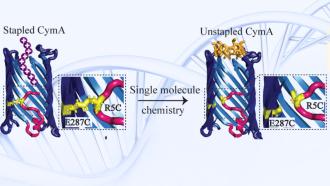Findings from a recent study in ‘messanger RNAs’ and ‘STAR proteins’ hold promise of helping in designing drugs.
Since many drugs have specific proteins as their targets, understanding how these targets interact with mRNAs could play a big role researchers say.
The study published in the journal Scientific Reports, by researchers from the Indian Institute of Science Education and Research (IISER) Mohali, dwells on some interesting discoveries on how messenger RNAs (mRNAs) bind to a class of proteins called ‘STAR proteins’. The study also throws some insight into the structural changes that these proteins then undergo.
The findings of the study could be used to design mutations and to identify amino acids that are essential for mRNA binding.
The Ribonucleic Acid (RNA) found in our cells was once thought of only as a messenger, relaying information from the DNA (the genetic material), to the ribosomes, to make proteins. The aptly called ‘messenger’ RNAs (mRNAs) do this by binding or sticking to specific protein molecules. Ribosomes then used this information to produce proteins that are needed by the body. Recent studies have now shown that RNAs do much more as they also function as switches, regulators, enzymes and also control many cellular events.
“Over the last three decades, the STAR family of proteins has generated lots of interest in scientific community. Every now and then, there is a new discovery in the role of a STAR protein with implications in critical functioning of the concerned organism.”, says Dr. Monika Sharma from the Department of Chemical Sciences, IISER Mohali and author of the study, who along with C. R. Anirudh, an undergraduate student from IISER Mohali, did this study.
The research was funded by Department of Science and Technology (DST), India, through the INSPIRE award and research grant.
Among the various proteins that mRNAs bind to, the STAR proteins (Signal Transduction and Activation of RNA) are special since they act as regulators of many processes that are related to cell development. These proteins are so important that they are found in the genomes of all organisms, from yeasts to humans, and are preserved in the process of evolution.
Using simulations, the researchers studied the interactions of mRNA bound complexes and the STAR domain of the QKI protein, a protein found in mammals. The QKI protein carries genes that are implicated in many diseases like cancer, neurological disorders such as ataxia, multiple sclerosis and schizophrenia. They carried out these simulations in the presence and absence of bound mRNA to understand how mRNA binding influences the STAR domain. They also studied the changes that occur to the structure of the STAR protein during the mRNA-STAR binding. They further investigated the process of how the mRNA unbinds from the STAR domain.
These results agree with other experimental research on mutagenesis, the process by which certain parts of an organism's genetic makeup can be changed . “If there is mutation observed in the QKI protein, one can speculate its effects. For example, whether it is interfering with the stability of the protein, or hindering the interaction of proteins with mRNA”, explains Dr. Sharma.
The research suggests that the binding of mRNA is an interaction between the selection of structures and the way they fit together with the binding protein partners, in the process, influencing the shape of the protein. The study could also aid in drug design since many drugs have specific proteins as their targets and understanding how these targets interact with mRNAs could play a big role here.
As a next step, the researchers are focusing on studying some more mRNA-STAR protein interactions. “I am currently pursuing the exact mechanism of the binding of mRNA with STAR domains using a series of sampling simulations. In addition, we are looking at what makes this short stretch of mRNA special, allowing it to bind to the STAR domain using a comparative analysis of simulations of several cognate mRNA sequences, which binds to these STAR domains, and non-cognate mRNA sequences, which do not.” says Dr. Sharma on the future directions of her research.






